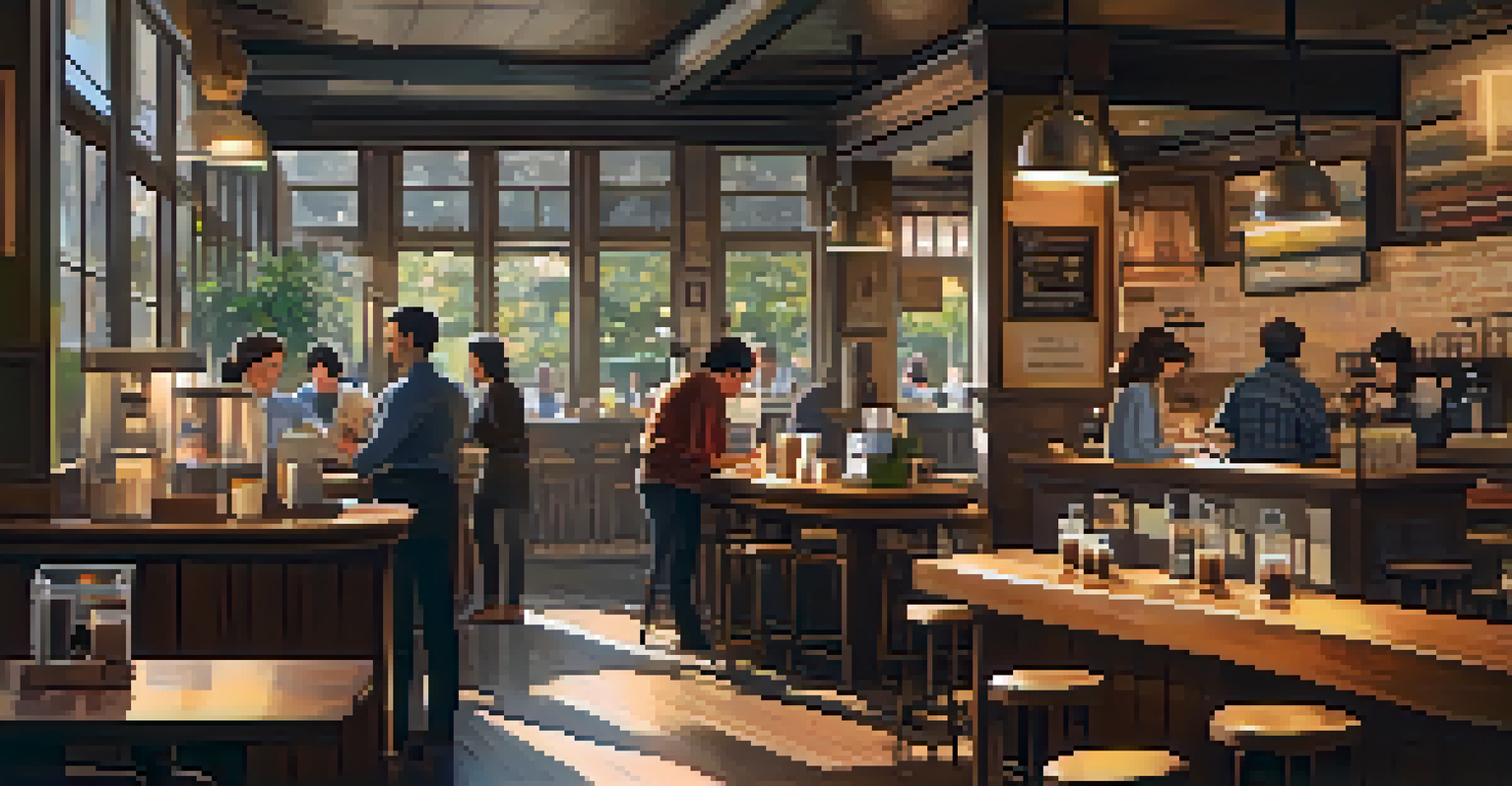Using Imagery in Lyrics: Painting Pictures with Words

The Power of Imagery in Songwriting
Imagery in songwriting is like a brush in the hands of an artist, allowing the songwriter to paint vivid pictures that resonate with listeners. It transforms simple words into powerful visual experiences, making songs more relatable and memorable. When listeners can visualize the emotions and scenes described in a song, they're more likely to connect deeply with the music.
Songs are like a time machine; they can take you back to a moment you thought you had forgotten.
Consider the way a well-crafted line can evoke a specific time or place. For example, when a lyric describes the golden hues of a sunset over an ocean, it can transport the listener to that serene moment. This ability to evoke imagery is what sets great songwriters apart from the rest.
Moreover, strong imagery can enhance the emotional impact of a song, creating a lasting impression. When words paint a picture that resonates with personal experiences, it allows listeners to feel understood and less alone in their struggles.
Types of Imagery Used in Lyrics
Songwriters often employ various types of imagery to convey different feelings and moods. Visual imagery, which appeals to our sight, is the most common, but auditory, olfactory, tactile, and gustatory imagery also play vital roles. Each type serves to create a multi-sensory experience that enriches the listener's engagement with the song.

For instance, auditory imagery can evoke sounds, like the ringing of a distant bell or the rustle of leaves, enhancing the atmosphere of the lyrics. This added layer of detail can make a song feel more immersive, as if the listener is experiencing the story firsthand. Similarly, olfactory and gustatory imagery can trigger nostalgic memories, adding depth and relatability.
Imagery Creates Emotional Connections
Imagery in songwriting transforms words into vivid experiences, allowing listeners to connect deeply with the emotions conveyed.
By mixing different types of imagery, songwriters can create a rich tapestry of emotions and experiences that resonate with diverse audiences. This blend keeps listeners intrigued and invested in the narrative being told.
Examples of Vivid Imagery in Popular Songs
Many popular songs showcase the power of imagery, making them unforgettable. Take, for instance, 'Firework' by Katy Perry, where the lyrics use vivid visual imagery to describe feelings of empowerment and self-worth. The metaphor of a firework bursting in the sky creates a striking image that inspires listeners to embrace their uniqueness.
Music can change the world because it can change people.
Another great example is 'Chasing Cars' by Snow Patrol, which paints a serene picture of lying in a field, focusing on the simplicity of love. The lyrics evoke a sense of peace and connection, transporting listeners to that moment of tranquility. This ability to create a visual scene enhances the emotional weight of the song.
These examples illustrate how effective imagery can elevate a song from mere words to an evocative experience that lingers in the mind long after the music stops. When listeners can visualize the story, they are more likely to remember and connect with it.
The Role of Metaphors and Similes
Metaphors and similes are powerful tools in songwriting that enhance imagery. A metaphor directly compares two unlike things, while a simile uses 'like' or 'as' to draw a comparison. Both devices allow songwriters to create vivid images that help convey emotions and messages in a relatable way.
For example, saying 'love is a battlefield' (a metaphor) evokes the intensity and struggles of romantic relationships without needing a lengthy explanation. On the other hand, a simile like 'your love is like a river' paints a picture of something flowing and constant, enhancing the emotional depth of the lyrics.
Types of Imagery Enhance Engagement
Different types of imagery, such as visual and auditory, enrich the listening experience and keep audiences intrigued.
When used effectively, these literary devices can encapsulate complex feelings in just a few words, making them memorable and impactful. They encourage listeners to think deeper about the lyrics while still enjoying the melody.
Building a Narrative Through Imagery
Imagery can also help build a narrative within a song, guiding the listener through a story. By painting scenes and moments, songwriters can create a progression that feels natural and engaging. This narrative structure helps listeners follow along, making them feel like part of the journey.
Take 'The River' by Bruce Springsteen, where the lyrics unfold a story of dreams, love, and loss. The imagery used throughout the song allows listeners to visualize the characters and their struggles, creating an emotional connection. Each verse builds on the last, leading to a powerful climax that resonates deeply.
This storytelling aspect of imagery in lyrics is what makes songs relatable and memorable. When listeners can envision the story being told, they are more likely to revisit those songs, finding comfort and connection in the shared experience.
The Emotional Impact of Imagery
Imagery has a profound emotional impact, as it taps into the listener's feelings and memories. When a songwriter uses descriptive language to evoke specific emotions, it can resonate with listeners on a personal level. This connection is what often makes songs timeless and universal.
For instance, lyrics that describe heartbreak using vivid imagery can evoke feelings of sadness and nostalgia. When listeners can envision the pain and loss expressed through the words, it amplifies their emotional response. This shared experience is what makes music such a powerful medium for expression.
Metaphors and Similes Add Depth
Using metaphors and similes effectively encapsulates complex feelings, making lyrics memorable and impactful.
By invoking strong emotions through imagery, songwriters can create a lasting bond with their audience. It's this emotional connection that keeps listeners coming back for more, as they seek to relive those feelings through music.
Crafting Your Own Imagery in Lyrics
If you're a songwriter looking to enhance your lyrics with imagery, start by observing the world around you. Pay attention to colors, sounds, scents, and textures that evoke emotions. Take notes on your observations and think about how you can incorporate them into your writing, creating vivid scenes that resonate with your audience.
Experiment with different types of imagery, such as metaphors and similes, to enhance the emotional depth of your lyrics. Remember that less can be more; sometimes, a single powerful image can convey a multitude of feelings. Don't be afraid to revise and play with your words until you find the perfect fit.

Finally, always consider your audience and the emotions you want to evoke. By crafting imagery that speaks to their experiences, you can create a deeper connection and make your lyrics more impactful. With practice, you'll find your unique voice and style, painting vibrant pictures with your words.